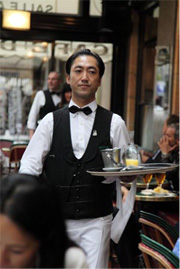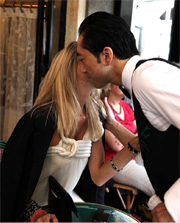Home > Highlighting JAPAN > Highlighting Japan FEBRUARY 2012 > Waiting with Distinction
Highlighting JAPAN
COVER STORY: At Your Service

Caption: Tetsuya Yamashita tries to “see everything, remember everything, detect everything, and guess some things but stay quiet about them.”
Credit: RYUSUKE HAYASHI
Waiting with Distinction
Among other things, Paris is well known for its cafés. We take a look at a Japanese garçon working at one such Parisian café.

Yamashita serves between 50 and 150 parties each day at Café de Flore.
Credit: RYUSUKE HAYASHI
A Café de Flore garçon (the word, which is French for “waiter,” has entered the English language) dressed in a white shirt, black vest, black bow tie and white tablier (apron) carries a tray holding coffee, wine and a croque-monsieur (a grilled ham and cheese sandwich) as he threads his way between the tables to serve an order with elegance. It was at such a sight that Sartre once remarked, “The garçons of Flore are actors, who each day act the part of Flore waiters on the stage that is Flore.”
Café de Flore garçons’ earnings come solely from the tables on which they wait. They receive 15% of the cost of drinks at their tables, plus tips. Today, few cafés still employ this commission-based wage system. Without a fixed wage, the garçons of Flore truly battle it out on their own. Unless you possess all manner of skills, including the stamina to continue working for more than ten hours each day, the receptiveness to quickly pick up on what a guest wants and the intellect to delight guests in conversation, you will not make it as a garçon at Café de Flore.
It is among the twenty full-time garçons who represent Paris as they work at the café that we find the lone foreigner, Tetsuya Yamashita.
“I embrace the motto, ‘faster, stronger and more beautiful’ and strive to deliver service that excites the senses of customers,” says Yamashita.

Yamashita greets a regular customer.
Credit: RYUSUKE HAYASHI
This has won Yamashita much support, including from the café’s manager, his fellow garçons and many customers. After the Great East Japan Earthquake, almost every café regular called him over to ask if his family was okay.
“I went around feeling touched by people’s love,” recounts Yamashita.
Yamashita serves between 50 and 150 parties each day. He draws on all of his senses to pick up on customer movements and deliver service with economy. For example, for customers who smoke, he instantly determines where on the table an ashtray should be placed. Even after finishing a day’s work, Yamashita remembers every order received from customers that day. “See everything, remember everything, detect everything, and guess some things but stay quiet about them.” With this, Yamashita expresses the secret to being a garçon.
“As the successor to one of France’s cultural assets, and as an envoy conveying the true wonder of cafés to Japan, I hope to work as a garçon my whole life,” says Yamashita.
© 2009 Cabinet Office, Government of Japan






